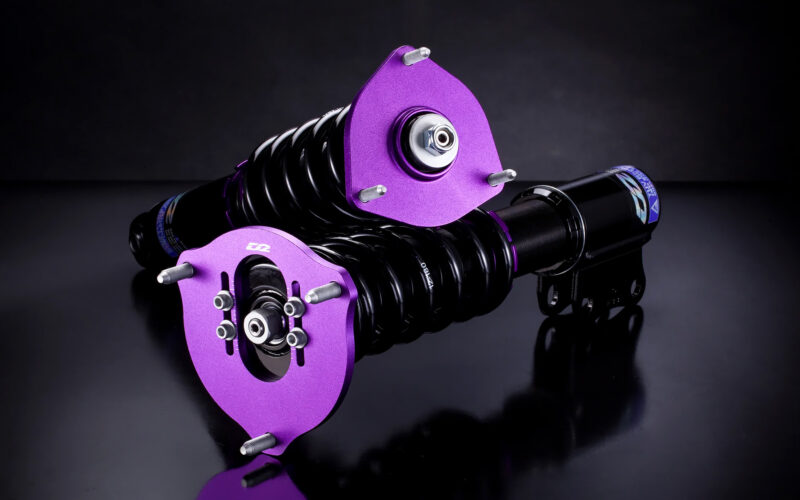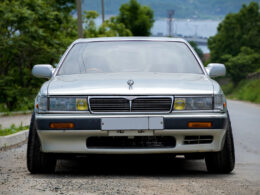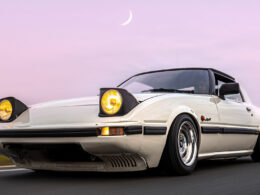Choosing the right wheel offset usually ends up being an afterthought when purchasing new rims. It’s not uncommon for buyers to get caught up in style and size decisions, while important measurements like offset fall by the wayside.
If you don’t have a specific fitment goal in mind, sticking to your OEM specified offset is ideal in order to avoid clearance issues. For context, most production cars have some amount of positive offset.
The problem only occurs when you find yourself on the extreme end of either positive or negative offset without knowing the implications it might have on your suspension setup.
In this article, we’ll explain what wheel offset is, how it differs from backspacing, and its effects on your suspension geometry.
What Exactly Is Wheel Offset?

If you’ve spent some time looking at aftermarket rims, you must’ve noticed how the mounting point isn’t always perfectly in the center. Sometimes it’s further outboard, towards the spokes, other times it’s more inboard, away from the spokes.
That’s what offset is all about. It refers to the distance between the centerline of the wheel and the surface where it mounts to your hub. It determines how far inward or outward your wheels will sit when they’re bolted on.
Positive vs Negative Offset

Think of offset as the degree to which the hub-mounting surface is off center. If it’s further outboard, towards the spokes, the offset is positive.
If it’s right in the center, then that’s zero offset, and if it’s inboard, closer to the suspension components, that’s negative offset.
Negative offset wheels stick out when they’re bolted to the hub, while positive offset rims sit inward, tucked into the wheel well.
Offset is measured in millimeters. For instance, +20 offset indicates that the hub-mounting surface of the rim is 20 mm away from the centerline, towards the outside. -20 offset will indicate the opposite.
Effects of Changing Your Wheel Offset: Good and Bad
Enthusiasts go for a change in wheel offset either for aesthetic or functional reasons. Whatever your goal is, it helps to know how these changes affect your car’s handling characteristics.
People usually switch to a different offset when installing a new set of wheels and tires. Since manufacturers offer the same rims in a diverse range of sizes and offsets, choosing the right one can get a bit overwhelming for anyone who’s new to all this.
To make things a bit simpler, here’s a brief summary of what you can expect from changing your wheel offset.
Negative Offset: Pros

Let’s start with the most popular offset change. People love installing negative offset rims for 2 main reasons:
- They look great
- They increase your wheel track.
However, there’s a little more to it than that. First, let’s consider how these two qualities will benefit your car and then inspect the cons.
Stance

All the rules go out the window when it comes to building a stance car, and that isn’t necessarily a bad thing. As long as you taper your expectations in terms of ride quality and make your peace with all the err… quirks that stance cars come with, it’s all good.
Lowered ride height, wider wheels, and fender flares are arguably the most important features that characterize this aesthetic. For this reason, negative offset wheels have carved a special place in the stance scene.
They’re pretty much a necessity if you want to install widebody kits, however, many stance car owners resort to using wheel spacers instead. While we don’t recommend running spacers, if form is the focus, then function will probably take a back seat.
Wheel Track (Good)

Wheel track refers to the distance between the centerline of both your wheels on the side-to-side axis. It affects the width of the car and consequently its handling or load-transfer characteristics.
It’s worth noting that installing negative offset wheels won’t affect your axle track, which is the distance between your hub flanges measured from side to side.
Wheel track width significantly affects the drivability and cornering performance of your car. For example, a shorter track width at the font compared to the rear will induce understeer. Similarly, going wider at the front and narrower at the rear will increase oversteer.
This is because of the altered load transfer profile. A wider front track will reduce load transfer to the outside tire during cornering, which helps to equalize the load across the inside and outside wheels to some extent.
This prevents a scenario where the outside tire does all the work while the inside tire is not adequately loaded, which is what improves lateral grip and cornering performance. Conversely, a narrower rear track leads to a swifter weight transfer, inducing oversteer.
Finding the sweet spot entirely depends on factors such as the car’s drivetrain layout (FWD or RWD), your desired handling attributes, whether it’s a dedicated track car or not, the type of motorsport you’re into (autocross or time attack), etc.
Negative Offset: Cons
Like any other suspension modification, changing your wheel offset has a ripple effect on other aspects of your wheel alignment and geometry.
To keep things simple, we’ll focus on the 3 main issues you need to be mindful of when installing negative offset rims.
Clearance Issues

Most of us buy into the causal fallacy that by pushing our wheels outward, there will instantly be more room for larger tires. This is not always true, especially when it comes to trucks or 4x4s.
We intuitively think that wheels pivot about their center when they’re turned, but in reality, they pivot about the steering axis, which is defined by the upper and lower ball joint (or upper strut mount in case of MacPherson struts).
In other words, since the steering axis is not vertical, the wheels don’t pivot on a dime; they swing around the arc established by the steering axis inclination. The more the wheel sticks out, the bigger the arc it swings around, pushing it closer to the car’s body at full lock.
This leads to issues with clearance, especially if you’re also running wider tires.
Excessive Wear On Axle, Bearings, and Driveline
Automakers factor in the stock wheel dimensions when dialing in tolerances for suspension and driveline components. The more your wheels pop out, the harder these components have to work.
When you increase your wheel track, especially by using negative offset rims as opposed to longer control arms, you’re essentially shifting the fulcrum of your tires’ contact patch further away from the steering axis.

This not only increases your scrub radius, which is a whole different issue in and of itself, but it also puts an excessive load on your axle, hub, steering knuckle ball joints, and control arm ball joints.
We recommend inspecting these components more frequently and possibly upgrading to beefier aftermarket alternatives.
Wheel Track (Bad)
A wider wheel track can either be a pro or a con depending on how you set it up. Even though it will give you better stability in high-speed corners, it will do so at the expense of steering feedback.
More wheel track width means increased scrub radius, which leads to more steering effort. It also significantly affects steering feel and kickback, especially when you drive over undulations at high speed.
Additionally, the wheels being cantilevered further out will not only put more strain on your suspension components, but also and make your springs feel softer.
It’s not uncommon for drivers to remedy the latter by installing stiffer springs, but by doing so on the extreme end, you’ll be pushing the limits of your slip angle and effectively your traction.
Positive Offset: Advantages

Unlike negative offset, which makes your wheels pop out, positive offset rims will tuck your wheels further inward.
Positive offset wheels are generally less invasive and a lot safer, especially when you consider that most production cars have them installed from the factory.
Below, you’ll find some of the most notable advantages of installing these on your car (or not taking them off if you already have them).
Clear Fenders Easily
In most cases, depending on how much you up size, fitting wider tires at the front can cause them to rub against the fender, especially when the wheels are bottomed out or at full lock.

Positive offset rims will help you to prevent this. However, it’s worth noting that determining proper offset when up sizing your rims and tires can be challenging. You’re going to have to perform several calculations prior to purchasing your preferred wheels and tires.
A Neater Look
If there’s one thing stance guys, hard parkers, and daily drivers can agree upon, is that neatly tucked tires look absolutely amazing.
One complaint we hear often is that fitting wider tires makes them stick out, which many enthusiasts don’t like the look of. Positive offset wheels will give you just enough “tuck” to clean up the overall look.
This way you can fit wider tires without it being extremely obvious, visually.
Positive Offset: Disadvantages
As they say, too much of anything is not good. Even though positive offset wheels are commonplace in production cars, overdoing it is going to cause a whole host of clearance issues.
These problems arise especially when up sizing wheels and tires, without accounting for how much space is available in the inner wheel well. Here are some of the drawbacks of running too much positive offset.
UCA Clearance

This is a common problem with SLA suspension considering how tightly all suspension components are packed and how little room there is in the wheel well.
Going too wide with the tires on positive offset rims often causes clearance issues with the upper control arm, especially at full lock and bump travel. For this reason, we recommend checking with people who own the same car as you and have dabbled in mods like these.
Either that or visit a reputed garage willing to figure out an unfussy combination of tire size and wheel offset suitable for your fitment goal. Failure to do so can result in expensive damage, but only if you’re pushing the limits of up sizing.
Brake Caliper Clearance

If you’re installing positive offset rims, it’s vital that you check how much space there is between the brake caliper and your rims.
Consider that your wheels will flex under load and your calipers will expand slightly when they get ripping hot.
Wheel Offset and Backspacing: Difference Explained
Offset and backspacing are two sides of the same coin. Even though they measure the same thing, it helps to think of them as separate specifications.

When you think of wheel offset, stuff like scrub radius, wheel track, suspension geometry, and fitment springs to mind. Backspacing, however, has more to do with leaving room for inboard components like your brakes, steering knuckle, control arms, etc.
Let’s compare the two for clarity:
- Offset: Measured from the wheel centerline to its hub-mounting point.
- Backspacing: Measured from the wheel’s inboard outer edge and its hub-mounting surface.
Lower backspacing indicates negative offset and consequently more inboard clearance, while higher backspacing indicates the opposite.
In light of the clearance issues mentioned above, one way to avoid them is by calculating the backspacing of your new wheels or by referring to the manufacturer specified numbers.
Wheel Offset and Scrub Radius

Of all the suspension geometry parameters that offset rims have an impact on, they affect scrub radius the most. This can either be a good thing or a bad thing, depending on how you set it up.
Scrub radius is the ground-level measurement between your steering axis inclination and the center of the contact patch. To reiterate:
- Steering axis / kingpin inclination: The off-vertical angle formed by an imaginary line passing through your UCA and LCA pivots, or upper strut mount and LCA if you have MacPherson struts.
- Centerline: An imaginary line passing through the center of the tire on a vertical axis.
Essentially, scrub radius is defined by the point in space where the steering axis intersects the wheel centerline.
If the intersection happens exactly at the contact patch, it indicates zero scrub radius. If the lines cross below the contact patch (inboard), that’s positive scrub, and if the intersection is above the contact patch, then that’s negative scrub.
Scrub radius isn’t a singular point. It’s characterized by the empty space between the centerline and the steering axis at the wheel base. That’s the part the tires are going to literally scrub against when you’re steering, braking or accelerating.

As we touched on earlier, wheels don’t turn on a dime when they’re steered, instead they swing around the steering axis which is defined by your control arm pivots.
The more your wheel sticks out away from the steering axis, the bigger the arc it swings around, which increases your scrub radius (positive). Conversely, if it tucks in, it reduces your scrub radius (negative).
Here’s how different scrub radius configurations can affect your car’s handling:
- Positive: Increased steering effort due to the wheel scrubbing over a larger contact patch. This leads to torque steer and a significant amount of kickback. However, the primary benefit is enhanced feedback and road feel.
- Negative: Most FWD cars utilize negative scrub radius. This design offers a balanced experience, providing a moderate level of steering effort, torque steer, and kickback, while sacrificing some amount of road feel.
- Zero: Zero scrub is super-rare and production cars don’t use it for a multitude of reasons. It makes the car steer smoothly and with minimal steering kickback when traversing bumps. However, this comes at the cost of diminished road feel and a lack of directional stability during cornering.
Different axle loads and drivetrain configurations require different scrub radius setups, and that’s only accounting for acceleration and braking. Turning and cornering performance is a whole different problem to solve.
Should You Run Spacers or Low Offset Rims?

If you wish to reduce your offset and make your wheels stick out a bit more, you can do so without having to splurge on new rims. Wheel spacers allow you to achieve virtually the same result at a fraction of the price.
For instance, a 10 mm spacer will add 10 mm of space between your hub and your rim’s mounting surface, effectively pushing it out by 10 mm. Their safety, however, is debatable.
The general consensus is that installing spacers introduces a potential point of failure at the most crucial mechanical juncture. Many people swear by them, others (including us) believe that using them is less safe than not using them.
This is why we feel that spacers and negative offset rims should not be thought of as interchangeable parts. If you must buy spacers, get the best you can afford; Eibach makes some of the best ones on the market.
Concluding Summary

At the end of the day, changing anything in your suspension (including wheel dimensions) will kick off a ripple effect that will ultimately nullify one of its key objectives. This is something to consider when changing your wheel offset drastically.
“Drastically” being the operative word. Oftentimes, the downsides of these alterations are blown out of proportion. Get in touch with fellow enthusiasts, local experts, and do a bit of experimentation to find out what works for you. Don’t forget to have fun with it.
Leave a comment below if you want to know more about wheel offset or if you wish to share some of your insights with us. While you’re here, feel free to check out our online shop and browse through some of our wheel and suspension upgrade catalogues.










